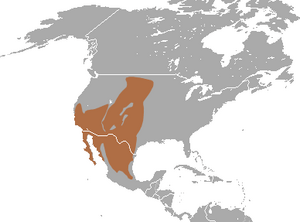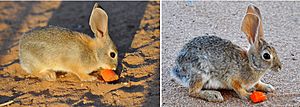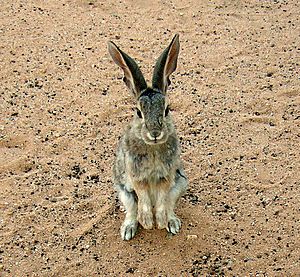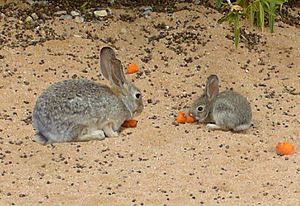Desert cottontail facts for kids
Quick facts for kids Desert cottontail |
|
|---|---|
 |
|
| Conservation status | |
| Scientific classification | |
| Genus: |
Sylvilagus
|
| Species: |
audubonii
|
 |
|
| Desert Cottontail range | |
The desert cottontail (Sylvilagus audubonii) is a common and cute rabbit found in North America. It's also known as Audubon's cottontail. This rabbit belongs to the Leporidae family, which includes all rabbits and hares. Unlike some other rabbits, desert cottontails don't dig big tunnels together. But they are quite friendly with other rabbits nearby.
Baby cottontails, called kits, are born in burrows that other animals have left. These rabbits sometimes dig shallow spots with their front paws to cool down or hide. They usually look for food in the early morning and evening. You won't often see them out on windy days. This is because the wind makes it hard for them to hear predators coming. Hearing is their main way to stay safe!
Contents
Lifespan of a Cottontail
Most desert cottontails that grow into adults live for less than two years. Their lifespan depends on where they live. Many animals that are bigger or faster than the cottontail hunt them. For example, snakes know where cottontails live. They can easily catch and eat the young kits. The mother rabbit cannot protect her babies from them.
Even though cottontails have many litters of babies each year, not many young rabbits survive to become adults. The ones that do survive grow very quickly. They are fully grown by the time they are three months old.
What Desert Cottontails Look Like
The desert cottontail looks a lot like the European rabbit. However, its ears are bigger and usually stand up straight. These rabbits like to be around other cottontails. They often gather in small groups to eat.
Like all cottontail rabbits, the desert cottontail has a grayish-brown, round tail. The tail has a wide white edge and a white underside. You can see this white part when the rabbit runs away. Its belly also has white fur.
Adult cottontails are about 36 to 42 centimeters (14 to 17 inches) long. They weigh between 700 to 1200 grams (1.5 to 2.6 pounds). Their tail is about 3 to 6 centimeters (1.2 to 2.4 inches) long. Their ears are 6 to 9 centimeters (2.4 to 3.5 inches) long. Their back feet are large, about 7 to 9 centimeters (2.8 to 3.5 inches) long.
Female cottontails are usually a bit bigger than males. But males tend to roam over a much larger area. A female's home area is about 1 acre, while a male's can be about 15 acres.
Where Cottontails Live
The desert cottontail lives across the Western United States. You can find them from eastern Montana to western Texas. They also live in Northern and Central Mexico. Their range just barely reaches into the Great Plains in the east. To the west, they live in central Nevada, southern California, and Baja California, reaching the Pacific Ocean.
These rabbits can be found at heights up to 1,830 meters (6,000 feet). They especially like the dry grasslands of the American southwest. But they also live in places that are not as dry, like pinyon-juniper forests. You can often find them near rivers or streams in dry areas too.
How Cottontails Behave
What Cottontails Eat
Cottontails are herbivores, which means they only eat plants. About 90% of their diet is grass. They also eat leaves and peas from mesquite plants. They munch on tree bark, fallen fruit, and the juicy pads of prickly pear cacti. Twigs from shrubs are also on their menu.
They rarely need to drink water. They get most of their water from the plants they eat or from dew. Like most lagomorphs (rabbits, hares, and pikas), they eat their own feces. This helps them get all the nutrients from their food.
Desert cottontails eat while on all fours. They use their nose to move and adjust the food in front of their paws. They turn the food with their nose to find the cleanest part before eating. The only time they use their front paws to eat is when the food is high up on a plant. Then, they lift a paw to bend the branch down so they can reach the food.
Staying Cool in the Desert
Desert cottontails need to control their body temperature well. This helps them avoid losing too much water in hot weather. They look for shaded areas to cool down. In open desert areas, they can handle very high temperatures, around 45°C (113°F), for a short time. They can lose a lot of water through sweating, about 1.5% of their body weight per hour. But they do much better in places with shade.
To cool off, they pant. Their body also changes how much energy it uses based on the outside temperature. The large ears of desert cottontails, which make up 14% of their body size, might also help them cool down.
Who Hunts Cottontails
Many desert animals hunt cottontails. These include birds of prey (like hawks and eagles), mustelids (like weasels), coyotes, bobcats, wolves, mountain lions, snakes, and even humans. If a cottontail is hurt or sick, even squirrels might attack it. Pets like cats and dogs can also be a danger.
Long ago, Native Americans in the Southwest hunted cottontails for meat. They also used their fur and hides. Today, people still hunt them for sport.
When a desert cottontail sees a predator, it usually freezes. It tries to blend in so it won't be seen. If it feels it's in danger, it will run away. It hops in a zigzag pattern to make it harder for predators to catch. Cottontails can run faster than 30 kilometers per hour (19 mph)! If a small predator or another cottontail threatens it, it might nudge with its nose or slap with its front paws. Sometimes, it will jump straight up, as high as two feet, if it's surprised or scared.
Losing their habitat due to land clearing and cattle grazing can really hurt cottontail populations. Fires started by humans are also a threat. Another challenge for them is competing with the black-tailed jackrabbit (Lepus californicus). Both rabbits eat the same food and live in the same places. If a season is very dry, there isn't enough plant life for all of them. The cottontail isn't afraid of the jackrabbit, which is actually quite shy. But the jackrabbit is much bigger and eats a lot more food.
Weather and Food Supply
A very wet winter means more plants will grow in the spring. This usually leads to more cottontail babies being born. However, if a wet winter is followed by a very dry summer, the plants dry up fast. This happens because of the extreme heat in the desert. This can cause hunger for the many cottontails that were born.
Status and Conservation
Since 1996, the desert cottontail has been listed as a species of least concern by the IUCN Red List. This means it is not in danger of disappearing. It is not on any state or federal list of endangered species.
The desert cottontail is considered a game species in the United States by state wildlife groups. It is also common throughout most of its range in Mexico. None of the twelve types of desert cottontails are thought to be in danger. No new conservation efforts are currently needed for them.
See also
 In Spanish: Conejo del desierto para niños
In Spanish: Conejo del desierto para niños






